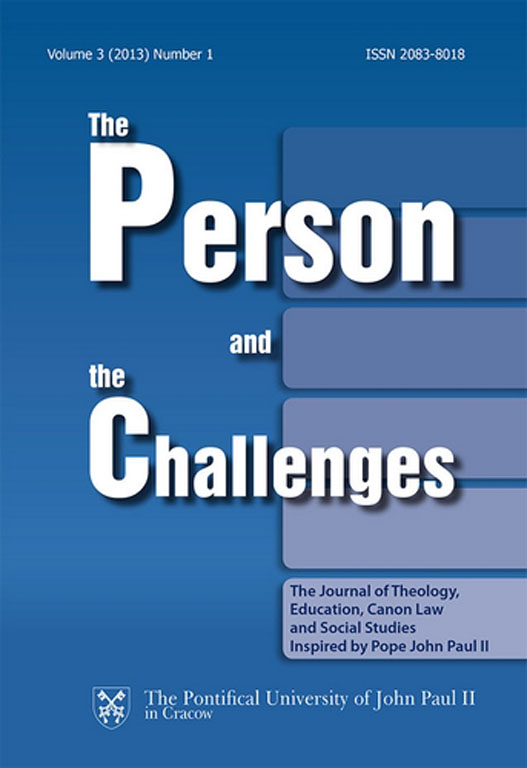The Hinge of Salvation: Body, Liturgy, and Bioethics
DOI:
https://doi.org/10.15633/pch.483Słowa kluczowe:
Person, body, communion of persons, John Paul II, liturgy, sacraments, Christian anthropology, dualism, utilitarianism, Incarnation, sacramentality, theology of the body, ritualAbstrakt
Dominant trends within the philosophical debate over personhood and identity tend to discount the significance and meaning of the human body and often slip into dualistic conceptions. I will argue that a Catholic theology of the body challenges many of the prevalent understandings in bioethics today. Such a notion takes Christ’s Incarnation as its foundation and seeks to develop an account of the human body in the context of the call to communion imprinted on humanity as made in the image of the Trinitarian communion of love. Such a conception counteracts forms of utilitarian or technological reductionism of the person. While Catholic bioethicists will need to consider how such an account will have practical applicability to cases, the call to communion ought to be fostered through the liturgical life of the Church, which enables Catholic bioethicists to develop a liturgical worldview that guards against devaluations of the dignity of the human person.
Bibliografia
Ashley OP, B., Theologies of the Body: Humanist and Christian, Braintree, MA, 1985, The Pope John Center.
Benedict XVI, Homily for the Feast of Sts. Peter and Paul, 29 VI 2008, Vatican City, http://www.vatican.va/holy_father/benedict_xvi/homilies/2008/documents/hf_benxvi_hom_20080629_pallio_en.html (24 IV 2013).
Benedict XVI, Sacramentum Caritatis, Vatican City, 2007, Libreria Editrice Vaticana.
Brown P., The Body in Society: Men, Women, and Sexual Renunciation in Early Christianity, New York 1988, Columbia University Press.
Bultmann R., Theology of the New Testament, vol. 1. New York 1951, Scribner’s.
Cahalan Kathleen A., Formed in the Image of Christ: The Sacramental-Moral Theology of Bernard Haring, C.Ss.R. Collegeville, MN, 2004, The Liturgical Press.
Cahill Lisa and M. Farley, Embodiment, Morality, and Medicine, Dordrecht 1995, Kluwer Academic Publishers.
Lauritzen P. (ed.), Cloning and the Future of Human Embryo Research, Oxford 2001, Oxford University Press.
Dworkin R., Life’s Dominion, New York 1993, Alfred A. Knopf.
Fagerberg, D., Virgil Michel on Liturgy and Social Justice: A New Appraisal, “Chicago Studies”, Vol. 48, No. 3 (Autumn/Winter 2009).
Fagerberg D., Theologia Prima: What is Liturgical Theology?, Chicago 2004, Hillenbrand Books.
Fletcher J., Four Indicators of Humanhood-The Enquiry Matures, “Hastings Center Report” Vol. 4, No. 6 (1975), p. 4–7.
Hauerwas S., Bailer C., Stoneking, Meador K.G., Cloutier D. (eds.), Growing Old in Christ, Grand Rapids, MI, 2003, William B. Eerdmans Publishing Company.
Hart DB., The Anti-Theology of the Body, “The New Atlantis” (Summer 2005), p. 64–73.
Jenson RW., Reading the Body, “The New Atlantis” (Summer 2005), p. 73–82.
John Paul II, Man and Women He Created Them, Boston 2006, Pauline Publishers.
John Paul II, Evangelium Vitae, Boston 1995, Pauline Publishers.
Prokes MT., Toward a Theology of the Body, Grand Rapids, MI, 1996, Eerdmans.
May W., Bioethics and Theology: How are they Related?, conference paper at “Congresso per la Federazione Dei Centri Internazionali di Inspiratione Personalista”, 9–10 VI 2003.
McKenny G., To Relieve the Human Condition: Bioethics, Medicine, and the Body, Albany 1997, SUNY Press.
Meilaender GC., Body, Soul, and Bioethics, Notre Dame, IN, 1995, University of Notre Dame Press.
Michel, O.S.B., V., The Liturgy as the Basis of Social Regeneration, “Orate Fratres” 9 (1935), p. 536–545.
Lammers S., Verhey A.(eds.), On Moral Medicine, Grand Rapids, MI, 1998, William Eerdmans Publishing Company.
Ratzinger J., Spirit of the Liturgy, San Francisco 2000, Ignatius Press.
Rousseau MF., Deriving Bioethical Norms from the Theology of the Body, “National Catholic Bioethics Quarterly” (Spring 2003), p. 59–67.
Saliers D., Anderson E.B., Morrill B. (eds.), Liturgy and the Moral Self. Humanity at Full Stretch Before God: Essays in Honor of Donald E. Saliers, Collegeville, MN, 1998, Pueblo.
Schmemann A., Liturgy and Tradition, T. Fisch (ed.), Crestwood, NY, 2003, St. Vladimir’s Seminary Press.
Smith HL., Where Two or Three are Gathered: Liturgy and the Moral Life, Cleveland, OH, 1995, The Pilgrim Press.
Vatican Council II, A. Flannery (ed.), New York 1998, Costello Publishing Company.
Waters B., This Mortal Flesh: Incarnation and Bioethics, Grand Rapids, MI, 2009, Brazos Press.
Wojtyła K., Love and Responsibility, HT Willetts (trans. and ed.), San Francisco 1993, Ignatius Press.
Pobrania
Opublikowane
Numer
Dział
Licencja
Prawa autorskie (c) 2013 John Christopher Sikorski

Utwór dostępny jest na licencji Creative Commons Uznanie autorstwa 4.0 Międzynarodowe.
Autorzy publikujący w czasopiśmie udzielają jego wydawcy zgody o następującej treści:
- Autor zachowuje autorskie prawa majątkowe do utworu, a jednocześnie udziela wydawcy czasopisma zgody na jego pierwszą publikację w wersji drukowanej i wersji online na licencji Creative Commons Uznanie autorstwa 4.0 Międzynarodowe oraz zgody na wykonywanie opracowań, w tym przekładów.
- Autor ma możliwość udzielania zgody niewyłącznej na opublikowanie utworu w wersji, która ukazała się w czasopiśmie (np. zamieszczenia go w repozytorium instytucjonalnym lub opublikowania w książce), wraz z informacją o jego pierwszej publikacji w czasopiśmie.
- Autor może umieścić swój utwór online (np. w repozytorium instytucjonalnym lub na swojej stronie internetowej) jeszcze przed zgłoszeniem utworu do czasopisma.

